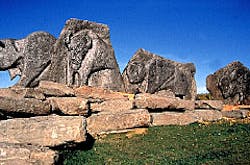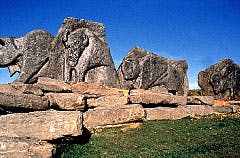Innovation key to sustainability as well as to oilsands success
Eric P. Newell
The gateway to the Wood Bison Trail features seven silt stone carvings by aboriginal artist Brian Clark, marking the entrance to the Syncrude Canada oilsands operations site.
- This wetlands area is part of the Matcheetawin Discovery Trails, an interpretive display showing Syncrude Canada's reclamation efforts and a wood bison viewpoint so that visitors can see a portion of Syncrude's wood bison herd. [19,683 bytes]
- Wood bison are shown grazing at Syncrude Canada's research facility on the northwest section of Syncrude's oilsands lease. Syncrude's herd of wood bison has grown to almost 200 today from 30 in 1993. [15,423 bytes]
It's a scene reminiscent of the way things once were: human, land, and beast coexisting in harmonious simplicity. But, today, it might be considered at odds with a world enmeshed in human conflict and defined by social and economic complexity.
The Wood Bison Trail-comprising massive sculptures, grazing land, recreational trails and viewpoints on Syncrude Canada Ltd.'s lease near Fort McMurray, Alta.,was built by the company and its partners from the Fort McKay First Nation on land reclaimed from oilsands mining. It is innovative. It goes beyond what's required. And, perhaps at first glance, it may seem to have little to do with the production of petroleum from Canada's oil sands.
Wood bison are anomalies. Decimated as a species, they are rarely, if ever, seen in a northern Canadian region that was once their natural habitat. They are also anomalies in the rare distinctiveness they lend to an extensive corporate program of environmental and loss management and overall responsible operation that, according to one of Canada's national newspapers, makes Syncrude one of the country's top corporate citizens.
It may be tempting in some quarters, of course, to brand any effort peripheral to direct business operations as not much more than window dressing-superficial work meant to keep potential dissenters happy or at least quiet. But, between incorporation and start-up, Syncrude had a lot more time to think than perhaps most companies-to think about technologies and processes that would help unleash the economic potential of the oilsands, certainly; but also about issues beyond the plant gate.
For example, would long-time residents in the area, primarily aboriginal people, welcome the new development or resent it? Would they help or hinder the operation? And what could Syncrude do to ease the path, to learn, to share opportunity, and to share the benefits of doing so?
A billion barrels of oil produced over 20 years of operations is an excellent barometer of business success and fitting testimony to the ingenuity of the people involved and of the efficiencies of the processes and technologies applied to the operation. But a billion barrels smoothly produced (6 years ahead of schedule) reflects the value and success of a multitude of beyond-the-gate partnerships based on common respect, understanding, and cooperation. They may not always add efficiencies to mine or plant operations yielding a direct and measurable cost saving (although they do in some cases). But partnerships-the kinds that produce innovative solutions to common challenges of land reclamation, for example, do pay dividends.
So, regardless of the obstacles that might be faced down the road, broad-based innovation helps lay the groundwork for a healthy and profitable future for Syncrude, the oilsands industry, and all of those involved.
Copyright 1999 Oil & Gas Journal. All Rights Reserved.

